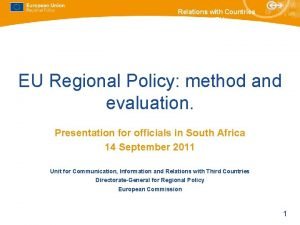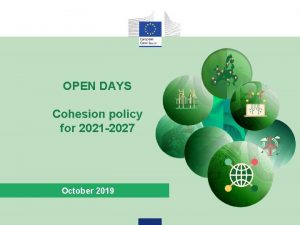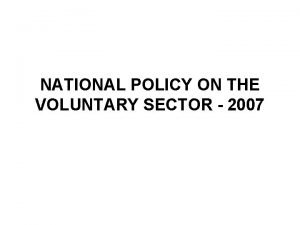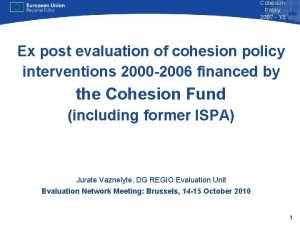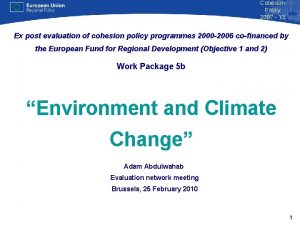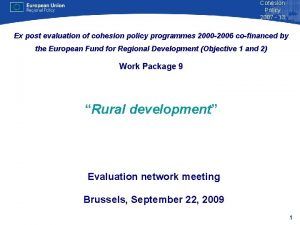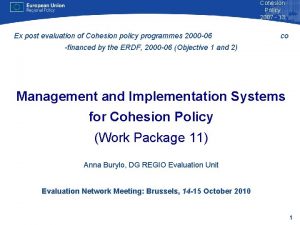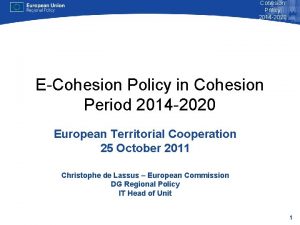Cohesion Policy 2007 13 Ex post evaluation of











- Slides: 11

Cohesion Policy 2007 - 13 Ex post evaluation of cohesion policy programmes 2000 -2006 co-financed by the European Fund for Regional Development (Objective 1 and 2) Work Package 7 “Effectiveness of Cohesion Policy: Gender Equality and Demographic Change” JOSE LUIS CALVO DE CELIS Evaluation network meeting Brussels September 21 st 2009 1

Cohesion Policy 2007 - 13 • Subject: to assess the impact of ERDF in supporting gender equality and enabling adaptation to demographic change • Scope: the study was restricted to appraisal of ERDF interventions Objective 1 or Objective 2 programme (2000 -2006 or 20042006) in 12 selected regions 2

Cohesion Policy 2007 - 13 ERDF areas of interventions As emerges from the literature review, the more relevant ERDF intervention for addressing the demographic and gender issues are: • measures directly aimed at specific target populations (like, for example, measures supporting female entrepreneurship and/or measures providing care, training and other social facilities for the active inclusion of women, the elderly and migrants) and/or • indirectly tackling these challenges (like measures addressing the urban/rural population imbalances) 3

Cohesion Policy 2007 - 13 Main findings (1/5) • Demographic change and gender equality issues are mentioned in most regional strategies and usually considered in the context analysis of the ERDF OPs …but find little further development in the intervention design, implementation and evaluation systems • In most cases few specific selection criteria and monitoring devices have been introduced and no attention has been paid to involvement of the relevant stakeholders 4

Cohesion Policy 2007 - 13 Main findings (2/5) • Nevertheless, the ERDF intervention areas assessed as relevant (mostly in an indirect way) to the issues at stake were carried out in all the case studies. • Indicatively, the analysed ERDF measures addressing demographic issues account on average in the case study for 23% of the total ERDF budget in the selected regions, while the analysed ERDF measures addressing (directly and/or indirectly) gender equality account on average for 21% 5

Cohesion Policy 2007 - 13 Main findings (3/5) • In terms of impacts, little or no quantitative evidence is available, also considering that no specific indicators were collected for the purpose. • However, the qualitative evidence shows that the ERDF interventions have had positive effects on demographic (such as ageing, depopulation and rural/urban imbalances, migration) and on gender equality (more work life balance) issues 6

Cohesion Policy 2007 - 13 Main findings (4/5) Measures with notable impact on both issues were: • ERDF support for care facilities for children and the elderly were more effective than specific measures both in creating employment opportunities for women and in improving women’s work-life balance • Interventions in social infrastructures and in regeneration projects in areas experiencing depopulation or deprived urban areas were indirectly beneficial for employment and quality of life of women, with potential positive effects on fertility rates 7

Cohesion Policy 2007 - 13 Main findings from the case studies (5/5) • Local authorities, SMEs and NGOs were relevant players for local development programmes to regenerate deprived areas and provide social services. • In most cases, the ERDF intervention showed high synergies with the ESF (training and counselling services) and the EQUAL (active inclusion of the elderly, migrant and female population) • EAGGF measures (Leader +) also showed synergies with the ERDF measures on infrastructures and services for depopulated areas. 8

Cohesion Policy 2007 - 13 Main lessons learned (1/2) • There is a scant awareness of the potentiality of the ERDF in addressing demographic change and gender equality. • Nevertheless ERDF may indeed support effectively regions in adapting to demographic change and fostering gender equality • The regional and local dimensions are relevant in addressing demographic change and gender equality. • … but while necessary, is not sufficient. To effectively address the multiple dimensions of demographic change and gender equality, it is necessary to adopt integrated and multi-level policy solutions. 9

Cohesion Policy 2007 - 13 Main lessons learned (2/2) • For delivering positive effects on gender equality it is not enough to set this as horizontal principle but to complement this with sound implementing measures. • To improve the effectiveness and sustainability of the ERDF interventions, appropriate management capacities are necessary at regional and local levels 10

Policy implications Cohesion Policy 2007 - 13 • Include ageing, migration and gender equality among the key priorities of ERDF intervention on the basis of specific local needs • Support the adoption of an integrated approach, combining economic, social and environmental measures • Promote a multilevel governance framework with a clear division of responsibilities for different types of interventions and appropriate intervention mechanisms and procedures • Promote new pro-active approaches and the exchange of experiences for institutional learning • Support management and implementation skills at the regional and local level • Improve monitoring and evaluation tools 11
